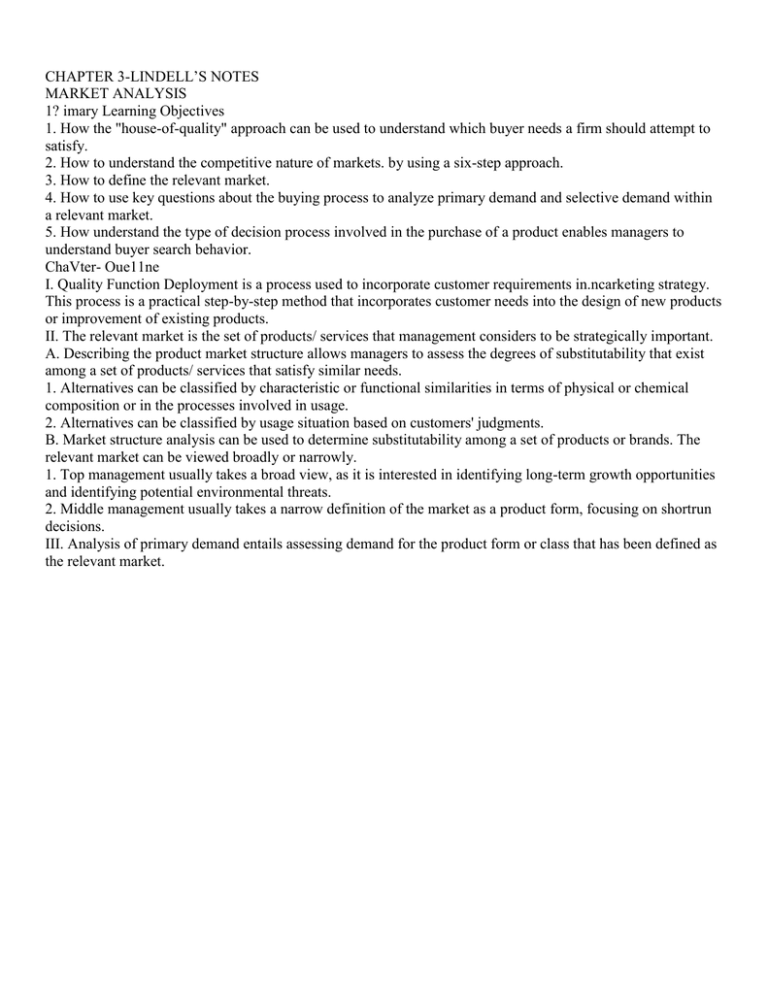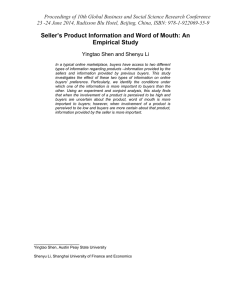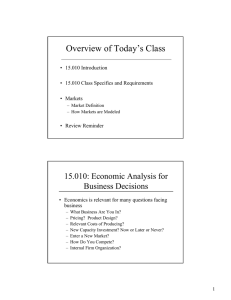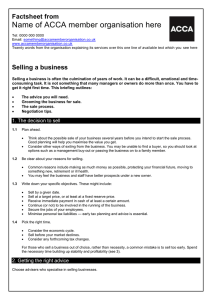ba 315 Cpt 3 LPC notes
advertisement

CHAPTER 3-LINDELL’S NOTES MARKET ANALYSIS 1? imary Learning Objectives 1. How the "house-of-quality" approach can be used to understand which buyer needs a firm should attempt to satisfy. 2. How to understand the competitive nature of markets. by using a six-step approach. 3. How to define the relevant market. 4. How to use key questions about the buying process to analyze primary demand and selective demand within a relevant market. 5. How understand the type of decision process involved in the purchase of a product enables managers to understand buyer search behavior. ChaVter- Oue11ne I. Quality Function Deployment is a process used to incorporate customer requirements in.ncarketing strategy. This process is a practical step-by-step method that incorporates customer needs into the design of new products or improvement of existing products. II. The relevant market is the set of products/ services that management considers to be strategically important. A. Describing the product market structure allows managers to assess the degrees of substitutability that exist among a set of products/ services that satisfy similar needs. 1. Alternatives can be classified by characteristic or functional similarities in terms of physical or chemical composition or in the processes involved in usage. 2. Alternatives can be classified by usage situation based on customers' judgments. B. Market structure analysis can be used to determine substitutability among a set of products or brands. The relevant market can be viewed broadly or narrowly. 1. Top management usually takes a broad view, as it is interested in identifying long-term growth opportunities and identifying potential environmental threats. 2. Middle management usually takes a narrow definition of the market as a product form, focusing on shortrun decisions. III. Analysis of primary demand entails assessing demand for the product form or class that has been defined as the relevant market. A. The key elements in analyzing primary demand concern answering buyer-identification questions and willingnessand ability-to-buy questions. 2. Buyer identification concerns determining the characteristics of existing users and buyers of the product form or class. The characteristics of buyers, the buying center, and customer turnover are used to determine what types of buyers would have a need for the product class or form. 2. The willingness and ability to buy is determined by the number of related products/services, usage problems, value or experience compatibility, and the perceived risks. 3. The perceived risks of using the product are classified in terms of economic or financial risk, time or convenience risk, performance risk, physical risk, social risk, and psychological risk. 4. The ability to buy is determined by cost factors, packaging and size factors, and spatial availability. Analyzing selective demand entails assessing the demand for a specific brand or supplier, with the key element being that managers understand how buyers make choices from the alternative brands or suppliers within the relevant market. A. The decision process is categorized into extensive problem solving, limited problem solving, and routinized response behavior. 1. Extensive problem solving occurs when buyers have no prior experience-in purchasing a product/service and when the product/service carries a high degree of perceived risk. 2. Limited problem solving occurs when buyers have a sound knowledge of the product category but still take time to compare and evaluate alternatives. 3. Routinized response behavior occurs when the decision deals with frequently purchased items. B. Identification of determinant attributes allows managers to assess the benefits sought by buyers and attributes conveyed by the product









